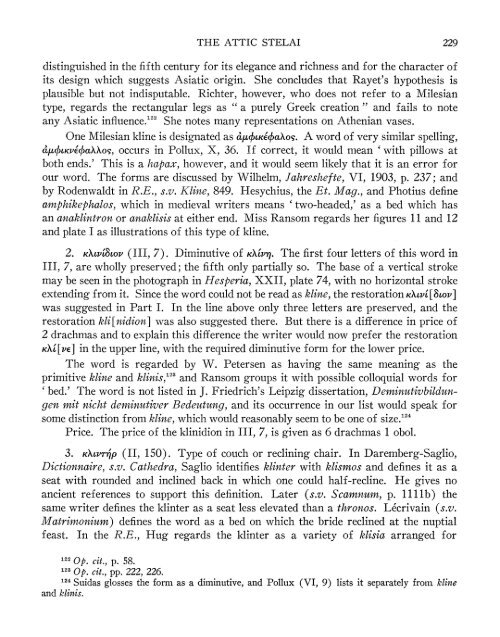the attic stelai - The American School of Classical Studies at Athens
the attic stelai - The American School of Classical Studies at Athens
the attic stelai - The American School of Classical Studies at Athens
Create successful ePaper yourself
Turn your PDF publications into a flip-book with our unique Google optimized e-Paper software.
THE ATTIC STELAI 229<br />
distinguished in <strong>the</strong> fifth century for its elegance and richness and for <strong>the</strong> character <strong>of</strong><br />
its design which suggests Asi<strong>at</strong>ic origin. She concludes th<strong>at</strong> Rayet's hypo<strong>the</strong>sis is<br />
plausible but not indisputable. Richter, however, who does not refer to a Milesian<br />
type, regards <strong>the</strong> rectangular legs as " a purely Greek cre<strong>at</strong>ion " and fails to note<br />
any Asi<strong>at</strong>ic influence.122 She notes many represent<strong>at</strong>ions on A<strong>the</strong>nian vases.<br />
One Milesian kline is design<strong>at</strong>ed as a fxKE'OaXog. A word <strong>of</strong> very similar spelling,<br />
afOLKVE'OaXXog, occurs in Pollux, X, 36. If correct, it would mean 'with pillows <strong>at</strong><br />
both ends.' This is a hapax, however, and it would seem likely th<strong>at</strong> it is an error for<br />
our word. <strong>The</strong> forms are discussed by Wilhelm, Jahreshefte, VI, 1903, p. 237; and<br />
by Rodenwaldt in R.E., s.v. Kline, 849. Hesychius, <strong>the</strong> Et. Mag., and Photius define<br />
am phikephalos, which in medieval writers means 'two-headed,' as a bed which has<br />
an anaklintron or anaklisis <strong>at</strong> ei<strong>the</strong>r end. Miss Ransom regards her figures 11 and 12<br />
and pl<strong>at</strong>e I as illustr<strong>at</strong>ions <strong>of</strong> this type <strong>of</strong> kline.<br />
2. KXW8t&ov (III, 7). Diminutive <strong>of</strong> KX&ATv. <strong>The</strong> first four letters <strong>of</strong> this word in<br />
III, 7, are wholly preserved; <strong>the</strong> fifth only partially so. <strong>The</strong> base <strong>of</strong> a vertical stroke<br />
may be seen in <strong>the</strong> photograph in Hesperia XXII, pl<strong>at</strong>e 74, with no horizontal stroke<br />
extending from it. Since <strong>the</strong> word could not be read as kline, <strong>the</strong> restor<strong>at</strong>ionKXW [8ov]<br />
was suggested in Part I. In <strong>the</strong> line above only three letters are preserved, and <strong>the</strong><br />
restor<strong>at</strong>ion kli[nidion] was also suggested <strong>the</strong>re. But <strong>the</strong>re is a difference in price <strong>of</strong><br />
2 drachmas and to explain this difference <strong>the</strong> writer would now prefer <strong>the</strong> restor<strong>at</strong>ion<br />
KXV[E] in <strong>the</strong> upper line, with <strong>the</strong> required diminutive form for <strong>the</strong> lower price.<br />
<strong>The</strong> word is regarded by W. Petersen as having <strong>the</strong> same meaning as <strong>the</strong><br />
primitive kline and klinis,'23 and Ransom groups it with possible colloquial words for<br />
'bed.' <strong>The</strong> word is not listed in J. Friedrich's Leipzig dissert<strong>at</strong>ion, Deminutivbildungen<br />
mit nicht deminutiver Bedeutung, and its occurrence in our list would speak for<br />
some distinction from kline, which would reasonably seem to be one <strong>of</strong> size."'<br />
Price. <strong>The</strong> price <strong>of</strong> <strong>the</strong> klinidion in III, 7, is given as 6 drachmas 1 obol.<br />
3. KXWVp (II, 150). Type <strong>of</strong> couch or reclining chair. In Daremberg-Saglio,<br />
Dictionnaire, s.v. Ca<strong>the</strong>dra, Saglio identifies klinter with klismos and defines it as a<br />
se<strong>at</strong> with rounded and inclined back in which one could half-recline. He gives no<br />
ancient references to support this definition. L<strong>at</strong>er (s.v. Scamnum, p. 111 Ib) <strong>the</strong><br />
same writer defines <strong>the</strong> klinter as a se<strong>at</strong> less elev<strong>at</strong>ed than a thronos. Lecrivain (s.v.<br />
M<strong>at</strong>rimonium) defines <strong>the</strong> word as a bed on which <strong>the</strong> bride reclined <strong>at</strong> <strong>the</strong> nuptial<br />
feast. In <strong>the</strong> R.E., Hug regards <strong>the</strong> klinter as a variety <strong>of</strong> klisia arranged for<br />
122 Op. cit., p. 58.<br />
123 Op. cit., pp. 222, 226.<br />
124<br />
Suidas glosses <strong>the</strong> form as a diminutive, and Pollux (VI, 9) lists it separ<strong>at</strong>ely from kline<br />
and klinis.
















